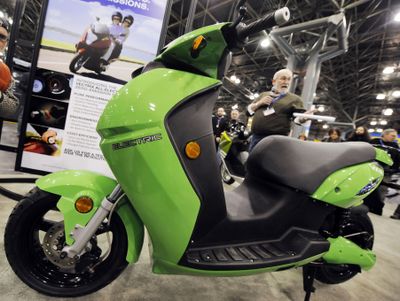Motorcycle makers downshift
New models focus on lower cost, higher fuel efficiency

NEW YORK – Motorcycle makers showcased cheaper and more fuel-efficient models at the nation’s premier motorcycle show Friday, as the industry tries to navigate a tough road of crippled consumer confidence and tighter access to credit that are weighing on sales.
The companies sought to drown out the gloomy news with the revved engines of 600 bikes from more than 250 exhibitors at the International Motorcycle Show, which runs through Sunday at the Jacob K. Javits Convention Center in Manhattan.
“We’re definitely seeing where manufacturers are taking advantage of the smaller motorcycles in their lineup, the motorcycles that don’t get the kind of attention when things are sort of economically strong,” said show spokesman Robert Pandya. “We’re seeing motorcycles coming in that were originally designed for other markets that, because of people’s consciousness for fuel economy and ease of getting around, are all of a sudden finding a home in the U.S.”
Scooter-maker Vectrix Corp. unveiled two electric models, while Italy’s Piaggio & C. SpA showed off its new Vespa GTS 300, which can reach 80 mph with a 278-cubic-centimeter engine that’s the biggest in Vespa’s line of trendy scooters. Honda Motor Co., Ducati and Kawasaki also displayed new bikes.
Middletown, R.I.-based Vectrix said it’s targeting younger, urban commuters with its two electric scooters. The VX-2 will have a base price just over $5,000 and will travel 40 to 50 miles on a charge, with a top speed of 30 mph. The VX-1E will cost about $3,500 more but can reach 62 mph with a range of 55 miles.
“The benefits of these in an urban environment are vast,” said Victor Pritzker, Vectrix’s director of North American sales. “The first is zero hydrocarbons. It makes you a good citizen. … The second is the cost of ownership. A tune-up on our vehicle is a computer upgrade.”
Honda debuted a chopper called the Fury with a lower riding position, a single-shock rear suspension with a hard-tail look, and a 1,312 cc V-twin engine. The Fury’s 71-inch wheelbase makes it the longest bike in the Japanese auto giant’s lineup.
Honda spokesman Bill Savino said the Fury will sell for about $13,000, which is less than many choppers – high-end bikes geared toward motorcycle enthusiasts that can cost tens of thousands of dollars or more.
“No one has ever made anything this affordable for that segment of the market,” Savino said.
Motorcycle sales tend to take a beating when the economy slows, and sales industrywide fell 2.2 percent in the third quarter of 2008, according to the Motorcycle Industry Council. In 2007, sales ended a 14-year growth streak by falling 6 percent.
In October, the top-selling U.S. motorcycle company, Harley-Davidson Inc., cut its 2008 sales forecast to between 303,500 and 306,000 motorcycles, down from 330,619 in 2007. The Milwaukee company is scheduled to report fourth-quarter earnings on Friday, and analysts widely expect it to report that profit for the full-year declined from 2007.
Takeo Fukui, chief executive of Honda – which began as a motorcycle company before it made its name in the car business – said in a speech last month the company’s global motorcycle sales slowed during the latter half of 2008 due to the credit crunch.
Motorcycles’ discretionary nature makes their purchase easy to delay and makes sales vulnerable to swings in consumer confidence.
“If you already are a motorcycle enthusiast or rider, you can probably make the current one you have last longer, said Robin Diedrich, senior consumer analyst for Edward Jones. “You don’t need to get that new model.”
Furthermore, many buyers borrow the money for their motorcycle purchases through financial institutions, and the recent freeze-up in the credit markets, with higher interest rates and stricter requirements for borrowers, has been another source of woe.
The motorcycle industry hasn’t totally wiped out. One bright spot has been sales of lightweight bikes like scooters, the smaller and typically more commuter-friendly two-wheelers produced by companies like Piaggio. Scooter sales in the U.S. surged 50 percent in the third quarter of 2008 compared with the previous year’s quarter, said Ty van Hooydonk, spokesman for the Motorcycle Industry Council.
“You’re seeing a lot of people who are looking for alternative transportation going to scooters and dual-purpose bikes,” Van Hooydonk said. Scooter sales might have been even higher last year if companies could have made more of them to keep up with the spike in demand, he said.